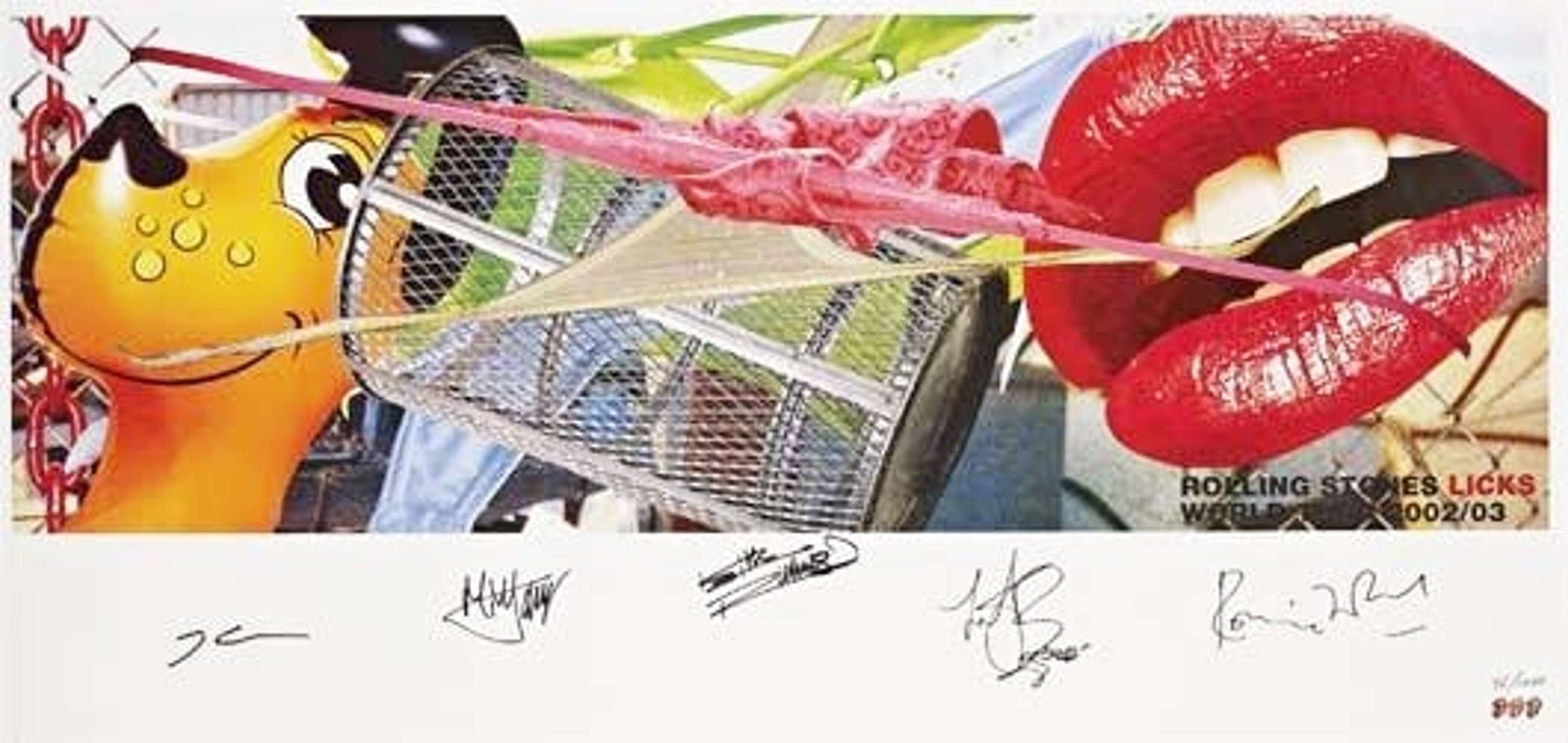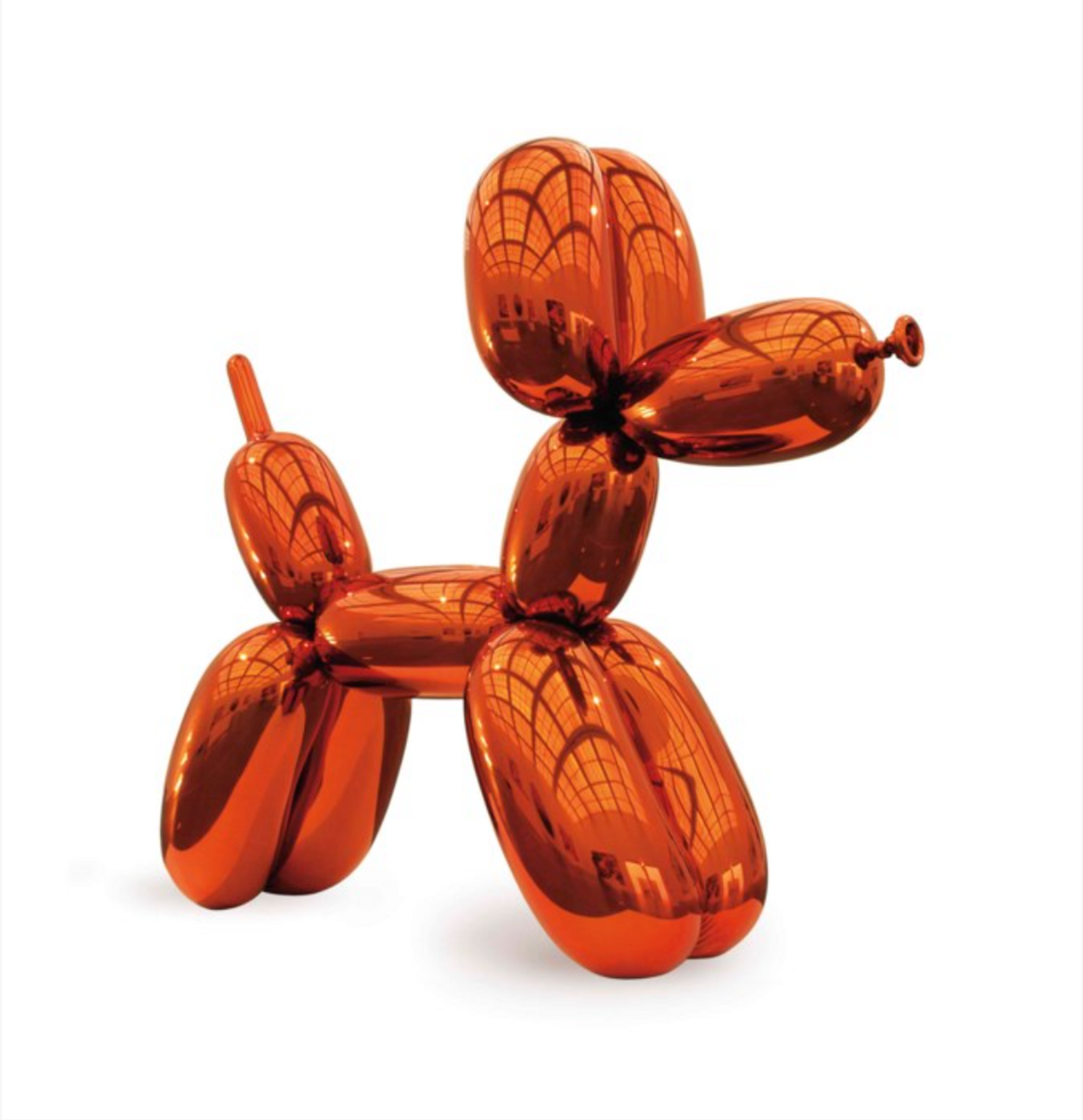 Rolling Stones Licks World Tour © Jeff Koons 2004
Rolling Stones Licks World Tour © Jeff Koons 2004
Interested in buying or selling
Jeff Koons?

Jeff Koons
28 works
The average value of Jeff Koons' prints now sits at around £8,563. When under the hammer, Jeff Koons' original paintings and sculptural works regularly sell for millions. The highest price ever paid for a Jeff Koons original achieved in May 2019, when Rabbit (1986) sold for a staggering £70.8m at Christie's New York. Koons’s most expensive artworks are often three-dimensional works, such as his Rabbits.
This article explores the most expensive Jeff Koons pieces sold at auction to date.
£70.8M for Rabbit
(US$91,075,000)
 Image © Christie's / Rabbit © Jeff Koons 1986
Image © Christie's / Rabbit © Jeff Koons 1986The work of ‘King of Kitsch’ Jeff Koons is known for attracting staggeringly high auction prices. The sale of Rabbit (1986) at Christie’s New York in May 2019 is a case in point; at the time it was the most expensive work of art ever sold by a living artist, realising a sale price of over US$91 million. The stainless steel sculpture, 1 of an edition of 3, was sold by the estate of the late magazine publisher and heir to Condé Nast, Samuel Irving Newhouse Jr. The work was bought up by hedge fund manager Steven A. Cohen, the owner of the New York Mets baseball team.
£36.5M for Balloon Dog (Orange)
(US$58,405,000)
 Image Christie's Balloon Dog (Orange) Jeff Koons 1994
Image Christie's Balloon Dog (Orange) Jeff Koons 1994 With the appearance of a balloon’s soft and malleable surface, the monumental stainless steel sculpture Balloon Dog (Orange) was created by American artist Jeff Koons in 1994. Part of Koons’s Celebration series, it realised an enormous US$58,405,000 at auction at Christie’s New York in November 2013.
Along with another of the artist’s sculptural works, Rabbit (1986), which sold for over US$91 million in 2019, Balloon Dog (Orange) broke the record for the highest auction price for a work by a living artist. Purchased by an unknown telephone buyer, Balloon Dog (Orange) was once owned by publishing tycoon Peter Brant.
£21.2M for Tulips
(US$33,682,500 )
A large-scale metallic sculpture in the form of a bunch of cartoon-like flowers, Tulips (1995) belongs to Jeff Koons’s Celebration series. Measuring two metres tall and five metres wide, Tulips (1995) sold for a similarly monumental US$33.6 million in 2012 at Christie’s auction house in New York.
Started in 1994, the Celebration series marked the aftermath of Koons’s split from his Hungarian-Italian wife, Ilona Staller. A subject of the artist’s highly controversial Made In Heaven (1990) photography series, first shown at the 1990 Venice Biennale, Staller took the pair’s newly-born son to Italy with her after a breakdown in their relationship. In an attempt to convince his young family to return to the US, Koons commissioned a series of sculptures representing life’s milestones.
£20.0M for Jim Beam - J.N Turner Train
(US$33,765,000 )
 Image © Christie's / Jim Beam – J.N. Turner Train © Jeff Koons 1986
Image © Christie's / Jim Beam – J.N. Turner Train © Jeff Koons 1986In May of 2014, Jeff Koons’s Jim Beam – J.N. Turner Train (1986) was acquired from London’s Anthony d’Offay Gallery for the princely sum of US$33.7 million. A particularly striking example of Koons’s early œuvre, the 9 and a half foot-long sculpture first appeared at the artist’s gallery debut, held at the international with Monument Gallery, New York. It forms part of the so-called Luxury and Degradation series – a number of works centring around the ironies of alcohol advertising. Some have interpreted the work as a reference to the industrial origins of the United States of America and its individualistic ‘frontier culture’.
£16.9M for Play-Doh
(US$22,812,500 )
 Image © Christie's / Play-Doh © Jeff Koons 1994-2014
Image © Christie's / Play-Doh © Jeff Koons 1994-2014Taking an astounding two decades to complete, Play-Doh is a complex work from the ever-divisive Jeff Koons. Scrapped several times during the course of its 20-year creation, in 2018 the work realised US$22,812,500 at an auction held at Christie’s New York.
Making its first appearance at the Whitney Museum of American Art in 2014, the work was initially constructed in polyethylene. When Koons realised this material failed to accurately recreate the texture of the popular modelling clay Play-Doh, from which the artwork takes its name, he turned to aluminium. Much like other examples of Koons’s sculpture, such as the iconic Balloon Dog (Orange) (1994), the use of this rigid and reflective material gives the work a semi-illusionist feel.
£16.7M for Popeye
(US$28,165,000)
 Image © Sotheby's / Popeye © Jeff Koons 2009-2011
Image © Sotheby's / Popeye © Jeff Koons 2009-2011Realised over a period of 3 years, Popeye (2009-11) is one of American artist Jeff Koons’s most iconic works. Attracting a total of US$28,165,000 in May 2014 at Sotheby’s auction house in New York, the piece was once the property of the Sonnabend Gallery in New York.
A sculpture comprising the distilled essence of Pop culture – a subject which fascinates Koons – it has been described as transcendental, recalling the spiritual powers of religious sculpture of the medieval period. A visual metaphor for masculine energy, the Disneyesque piece is imbued with Koons’s playful approach to contemporary mass culture.
£16.3M for Balloon Monkey (Orange)
($25,925,000 )
 Image © Christies / Balloon Monkey (Orange) © Jeff Koons 2006-2013
Image © Christies / Balloon Monkey (Orange) © Jeff Koons 2006-2013 A series that has continually grown in size since its commencement in 1994, Celebration is perhaps the most important feature of Jeff Koons’s career.
Performing less well than other examples of the artist’s ‘Celebrations’, such as Balloon Dog (Orange) (1994), in 2014 Balloon Monkey (Orange) (2006-2013) sold for US$25,925,000 at Christie’s New York. One of five unique versions in red, yellow, blue, magenta and orange, the sculpture was designed by Koons and manufactured by a specialist team of California-based engineers. A reference to a motif of classical art history – the monkey – the sculpture is testament to Koons’s inspiration by artists of the past, such as Renoir and Cézanne.
£14.1M for Cracked Egg (Magenta)
 Image © Christie's / Cracked Egg (Magenta) © Jeff Koons 1995-2000
Image © Christie's / Cracked Egg (Magenta) © Jeff Koons 1995-2000Taking 12 years to create, Cracked Egg (Magenta) is one of the most impressive features of American artist Jeff Koons’s œuvre. With a pre-sale estimate of £10-15 million, the work promised to be one of the most significant of Koons’s works to be offered in London for almost 10 years.
In February 2014, it lived up to expectations and realised an enormous £14,082,000 at Christie’s. A symbol of birth and creation, the sculpture renders the humble egg, a major art historical motif, in stainless steel. A hardy material that suggests the strength of Koons’s creative practice, it contrasts with the fragility of the egg shell, which here has been broken in a metaphorical figuration of transcendence - an important theme in Koons’s work. This particular ‘Celebration’ is designed to instil confidence in the viewer and enable them to achieve their dreams.
£12.9M for Balloon Flower (Magenta)
 Image © Christie's / Balloon Flower (magenta) © Jeff Koons, 1995-2000
Image © Christie's / Balloon Flower (magenta) © Jeff Koons, 1995-2000By now, Jeff Koons’ love for flowers is well known: “I have always enjoyed flowers. Since taking art lessons as a child, I have had flowers in my work. I always like the sense that a flower just displays itself. The viewer always finds grace in a flower. Flowers are a symbol that life goes forward” the artist said.
One of his most popular motifs, it is no surprise to see another Koons flower work, part of his Celebration series, figure among the top 10 of his most expensive works ever sold. The monumental steel sculpture Balloon Flower (magenta) went under Christie’s hammer in 2008 and fetched an astounding £12,921,250, making it the ninth priciest work by the artist.
£11.4M for Hanging Heart (Magenta/Gold)
(US$23,561,000 )
 Image © Sotheby’s / Hanging Heart (Magenta/Gold) © Jeff Koons 1994-2006
Image © Sotheby’s / Hanging Heart (Magenta/Gold) © Jeff Koons 1994-2006This larger-than-life sculpture by American artist Jeff Koons belongs to the so-called Celebration series – an ongoing series of works begun by the artist during the 1990s. Entitled Hanging Heart (Magenta/Gold), it sold for US$23,561,000 at Sotheby’s New York in November 2007, smashing its pre-sale estimate by almost US$4 million.
The piece was snapped up by billionaire French art collector François Pinault - the owner of Venice’s Palazzo Grassi and Punta della Dogana galleries and Paris’s newly-opened Bourse de Commerce – having been previously owned by American art magnate, Larry Gagosian.
